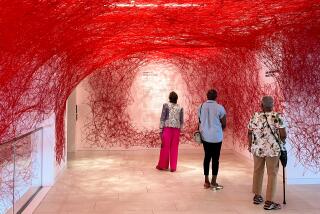Cathedral’s Textile Lab Finds Mission Close to Home
NEW YORK — In the hushed Textile Conservation Laboratory at the Cathedral of St. John the Divine, workers spend the day bending over centuries-old tapestries and carpets from collections nationwide, carefully analyzing fiber, cleaning and rewarping.
They never expected one of their greatest challenges to come from home.
“It was shocking,” said Marlene Eidelheit, the lab director, recalling the electrical fire last Dec. 18 that started in the cathedral’s gift shop.
The blaze badly damaged two 17th century tapestries, “The Last Supper” and “The Resurrection,” from the official papal Barberini looms of Italy.
The tapestries, which had been hanging on a wall of the cathedral nave, were scorched from the top down and lay on the floor in black, smoldering heaps.
Both were 40% destroyed, the figures of Christ and the apostles all but gone from “The Last Supper,” a 16-by-17-foot work, and an image of Christ and the cross obliterated from the slightly smaller “The Resurrection.”
Considered one of the nation’s top textile conservation laboratories, the shop handles works for such institutions as the J. Paul Getty Museum in Los Angeles, the Metropolitan Museum of Art in New York, the Detroit Institute of Arts and the Philadelphia Museum of Art.
But its seven full- and part-time experts have shown a special commitment to restoring the two fire-damaged Barberinis so they again can grace the cathedral -- a 19th century, neo-Gothic landmark on Manhattan’s Upper West Side.
Before the smoke cleared, Eidelheit had the tapestries carefully moved to the nearby lab, where they were gently unrolled, hosed with deionized water and vacuumed by workers lying on a mobile platform that slides above the table.
A mesh screen below collected debris: pieces of stained glass and lead, plaster, buckets of dirt and tiny pieces of charred tapestry.
In the ensuing months, the tapestries were reinforced with a nylon net backing, cleaned and vacuumed repeatedly, and their condition documented.
Even now, the restorers continue to test burned sections, including hundreds of fragments that range from an inch to several feet in diameter. Most are unrecognizable; many may never be reattached.
But two larger fragments -- of the head of the apostle John and the B emblem representing the Barberini family -- will likely be sewn back onto the intact part of “The Last Supper.”
Eidelheit estimates that the entire process -- being done in consultation with historians, museum curators and Barberini scholars -- will take two to three years.
Donated to the cathedral in 1891, the tapestries are part of a set of 12 Barberini hangings woven in the mid-1600s, under the direction of Florentine Cardinal Maffeo Barberini, for the nephew of Pope Urban VIII. The other 10 were spared in the fire.
Eidelheit said the specialty of the lab is conservation -- protecting what exists -- rather than restoring or replacing what is lost.
“We are not trying to make it look brand new or the way it was originally,” she said. “We do a lot of documentation, a lot of nonintrusive treatment.”
Since 1981, the textile lab has occupied the site of a former orphanage and museum in the quiet 13-acre oasis amid the bustle of Morningside Heights. Narrow walkways, gardens and sculptures surround the building, connected to the cathedral by a long corridor.
Using traditional and modern techniques, the lab handles a wide range of textiles, including needlepoint, upholstery, carpets and costumes, 35% of which come from private owners.
The vital first steps of any such work are anything but glamorous. They involve vacuuming, wet cleaning and testing for color, acidity or alkalinity and fiber.
In a small side room, dyes are tested, made and archived. “We keep every recipe,” Eidelheit said.
On a recent November day, Italian intern Sabrina DeVanna was testing ways to back a fragile 1800-vintage American sampler. In addition to stabilizing it, cleaning was required to remove blotchy stains.
The same day, technicians gently cleaned a Belgian lace handkerchief, a family heirloom and wedding keepsake with hand-stitched dates: 1875, 1915, 1941 and 1969.
Normally the conservators use a “tabby weaving” technique to stabilize weak areas, which assistant director Valerie Soll described as “going from the strongest point outside the weak point with enough space between each row.”
But in the case of the Barberini tapestries, the technique can be used in only a limited manner because of the damage.
“This piece will definitely need a different strategy because of the percentage that was lost,” said Soll, referring to the “Last Supper” laid out on the floor with some sections, charred beyond recognition, on a table nearby.
“Will they hang again? It’s still a big unknown,” Eidelheit said. “They may need some kind of total support, like a slant board, instead of them literally hanging upright.”
Whatever method is used, she said, the tapestries “won’t be as they were. They are now immense archeological artifacts, and the fire is part of their history.”
More to Read
The biggest entertainment stories
Get our big stories about Hollywood, film, television, music, arts, culture and more right in your inbox as soon as they publish.
You may occasionally receive promotional content from the Los Angeles Times.










